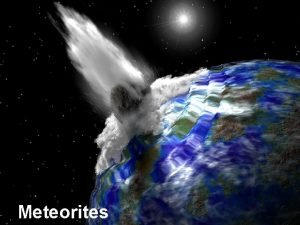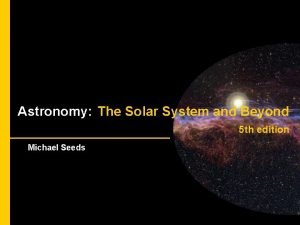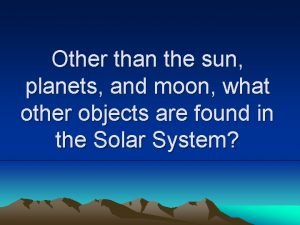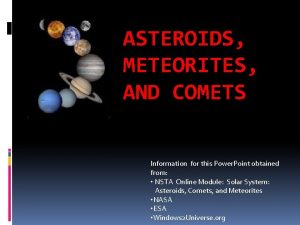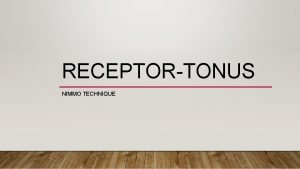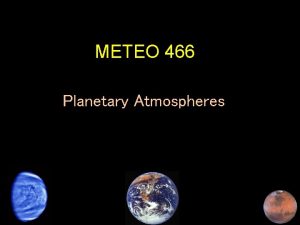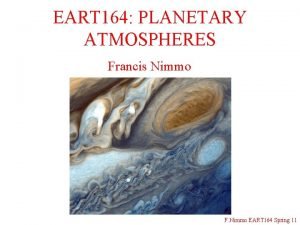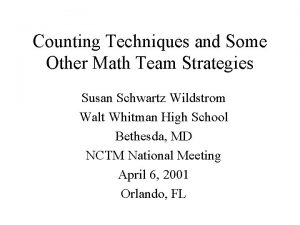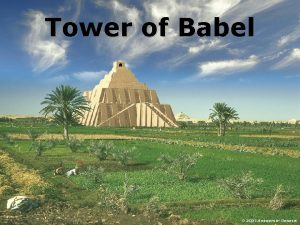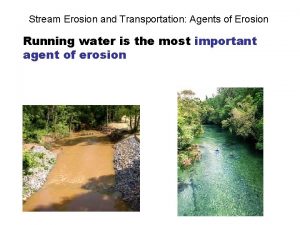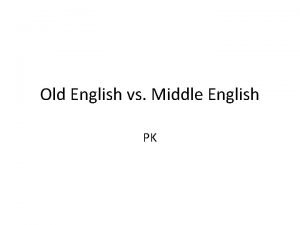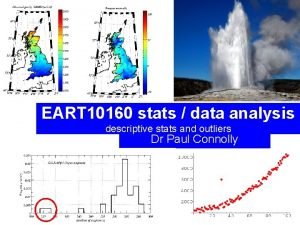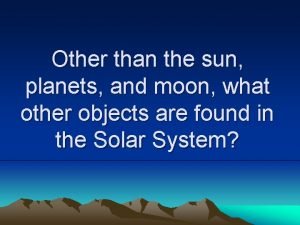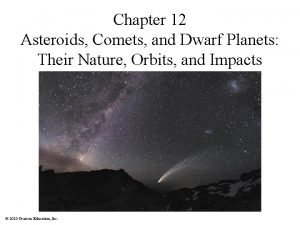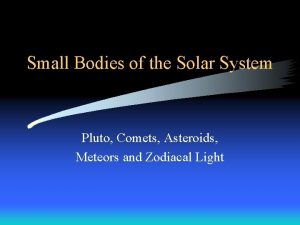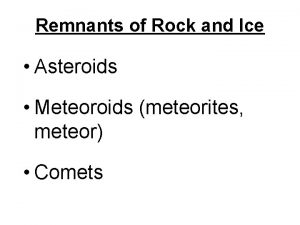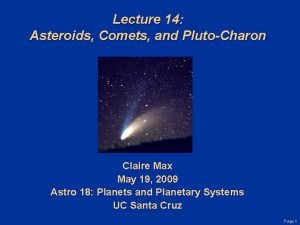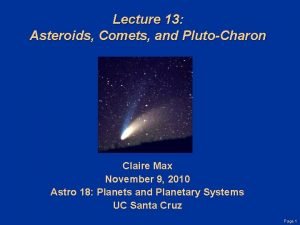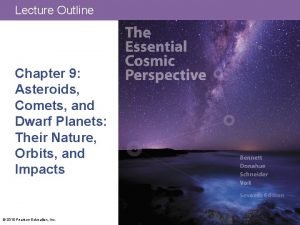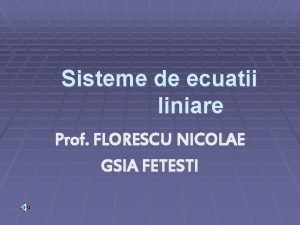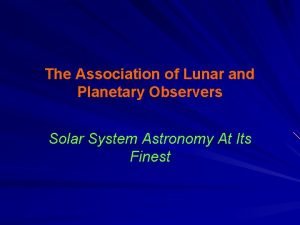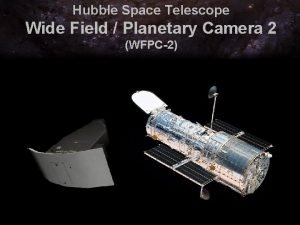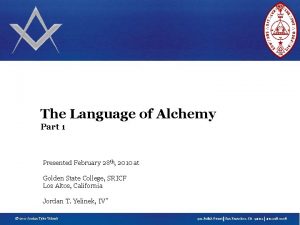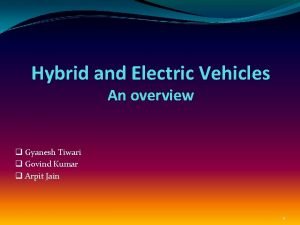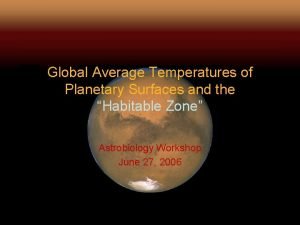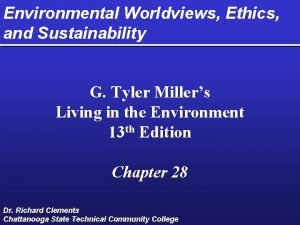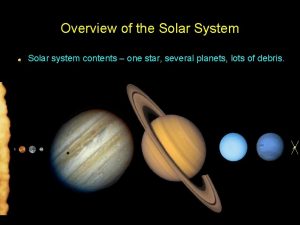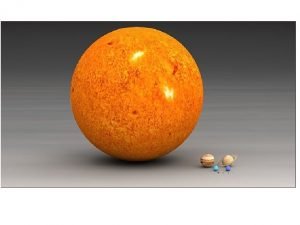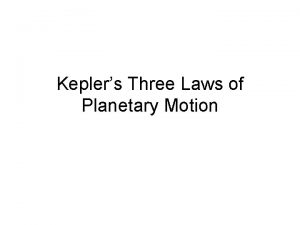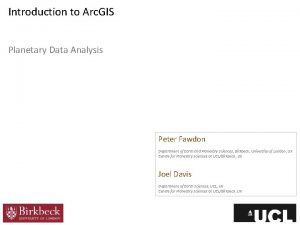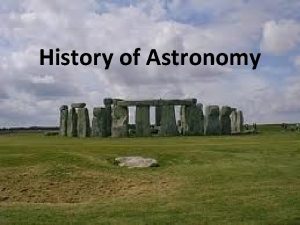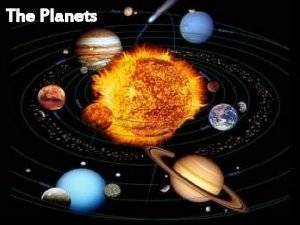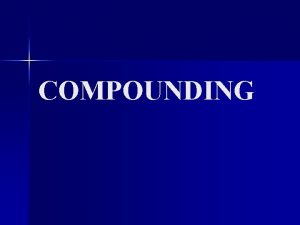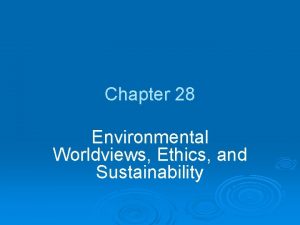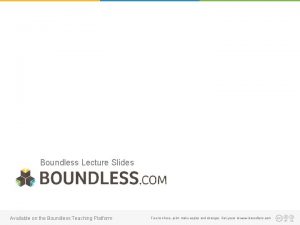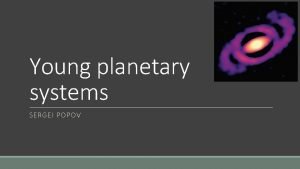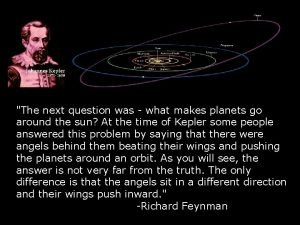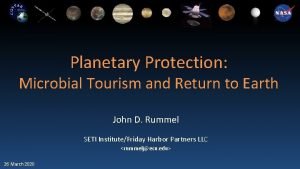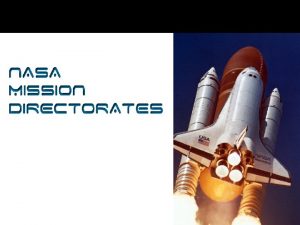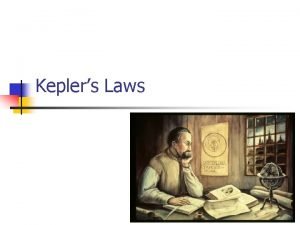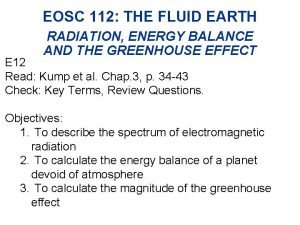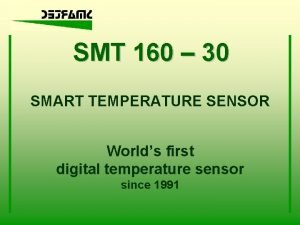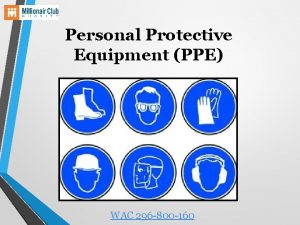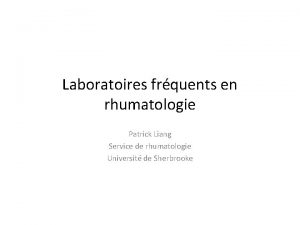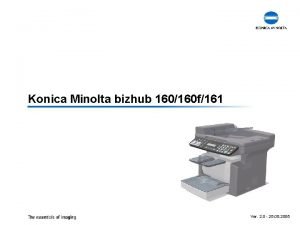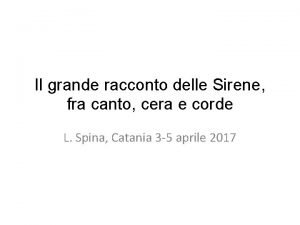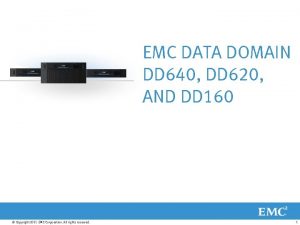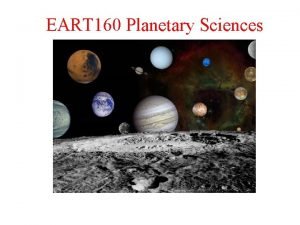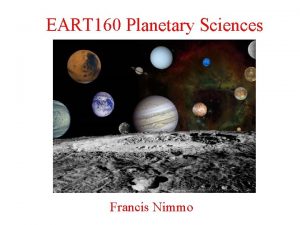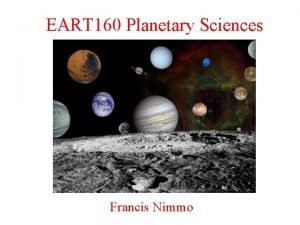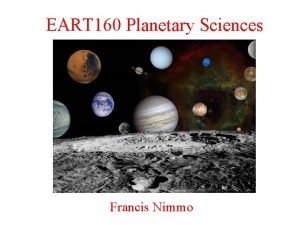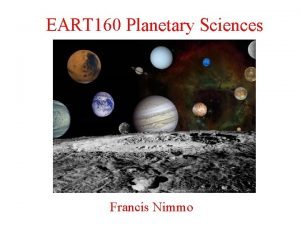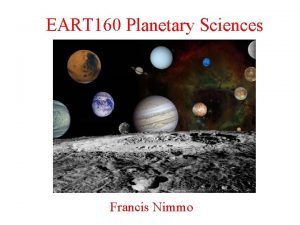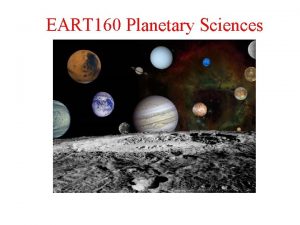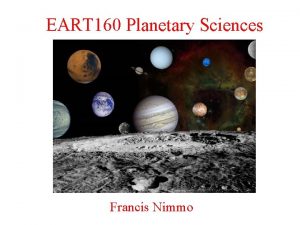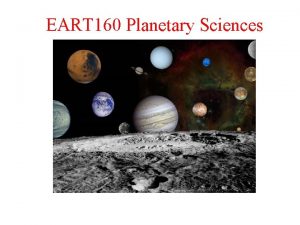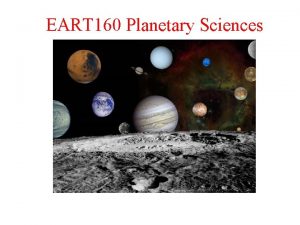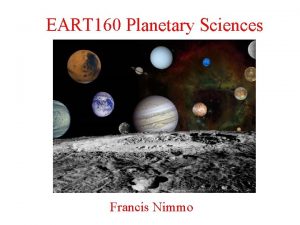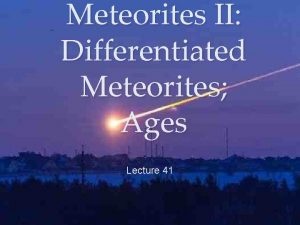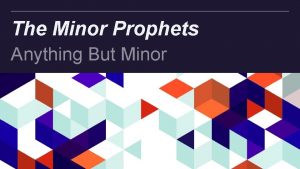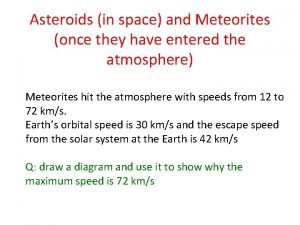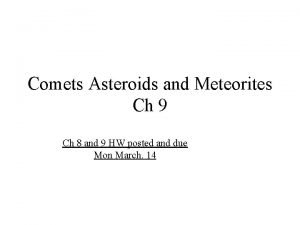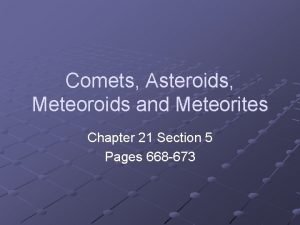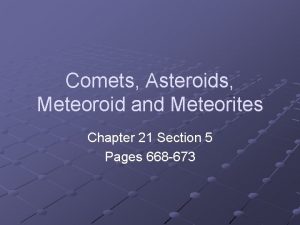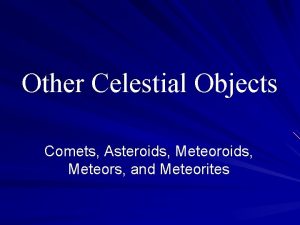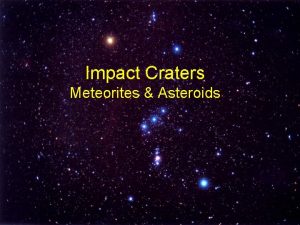EART 160 Planetary Sciences Meteorites Asteroids and Minor






















































- Slides: 54

EART 160 Planetary Sciences

Meteorites, Asteroids, and Minor Bodies

Meteorite-Asteroid Connections From Kring (2006), Unlocking the solar system’s past, Astronomy, August, pp. 33 -37.

Asteroid Belt

Formation/evolution • Mass: ~5% of Moon’s mass • Previously believed to be an exploded or disrupted planet. • Now believed to closer to “failed planet. ” • Gravitational perturbations by Jupiter prevented final accretion of planetesimals and promoted large orbital changes, and ejections. – Initial mass of belt may have been 100 -1000 times greater. – Cleared within millions of years – Ceres (500 km radius) is the largest body left.

Historical aside: Titus Bode “Law” (year 1715) a = 0. 4 + 0. 3 2 n n = -inf, 0, 1, 2… (k=2 n) Believed to be a coincidence, more of a “rule” than a “law. ” Asteroid belt approximately takes the position of a predicted planet (Ceres discovered 1801) Neptune doesn’t work (1846). Pluto? Not the best rule or law!

Kirkwood Gaps – evidence of Jupiter’s effect • Destabilizing mean motion resonances with Jupiter deplete zones of semimajor axis.

Lagrangian Points & Trojans Definition: Points where the gravity of two large bodies provide a centripetal acceleration that permits a third body to remain stationary in a rotating reference frame. Trojans (and Greek camp) – Dynamical group: occupy Sun-Jupiter L 4 and L 5 are stable like the bottom of a valley (attractor) L 1 -L 3 points are stable like a ball on a hill (or ridge)

Hildas – dynamical group • 3: 2 Mean motion resonance with Jupiter • Smaller semi-major axis than the Trojans • Moderate eccentricities • Triangular distribution, avoid Jupiter (aphelia opposite Jupiter)

Large asteroids Now a dwarf planet

Ceres (more later) Hubble image, contrast enhanced

Dwarf Planet Definition • International Astronomical Union (IAU): A celestial body orbiting a star that is massive enough to be spherical as a result of its own gravity, but has not cleared its neighboring region of planetesimals and is not a satellite. – Hydrostatic equilibrium • Problems with this definition? • Still debated

Dwarf Planets Name Region of Orbital Solar System radius (AU) Orbital period (years) Mean orbital Inclination to speed Eccentricity ecliptic (°) (km/s) Equatorial Diameter (km) Ceres Asteroid belt 2. 77 4. 60 17. 882 10. 59 0. 080 974. 6 3. 2 Pluto Kuiper belt 39. 48 248. 09 4. 666 17. 14 0. 249 2306 10 Haumea Kuiper belt 43. 34 285. 4 4. 484 28. 19 0. 189 Makemake Kuiper belt 45. 79 309. 9 4. 419 28. 96 0. 159 Eris Scattered disc 67. 67 557 3. 436 44. 19 0. 442 1150 +250 100 1500 +400 2340

Asteroid Classifications • • • Spectral categories C-group: carbonaceous, ~75%, albedo < 0. 1 S-type: siliceous composition (stony), ~17% M-group: metallic, but diverse interpretations Other, less common types exist Generally, people think of C-group, S-group, and M-group corresponding to meteorites of carbonaceous, siliceous, and metallic composition.

Near Earth Objects/Asteroids • More easily accessible by spacecraft. • Impact the inner planets • Perihelion < 1. 3 AU – but could have high e • There about 7000 documented NEOs, almost all asteroids (NEAs). • The largest is ~32 km in diameter (1036 Ganymed).

NEA examples 433 Eros, 34 x 11 km Second largest NEO

Why go to an asteroid? • Can’t you just study meteorites?

Just One Reason: Space Weathering • Vapor is produced by solar wind and micrometeorites. • Iron particles condense from vapor, with nanometer length scales • This reddens and darkens the surface • Fresh materials are bright, but old materials are darker and have weaker spectral bands. • This makes it difficult to determine what an asteroid (or the Moon) is really made of. Samples collected with proper context could help resolve this issue

Other reasons • What do they look like? – How did they form? – Interior structure? – Evolution?

OSIRIS-Rex • Launch 2016, return sample in 2023 from the 500 -meterasteroid Bennu Radar image of Bennu

NEAR mission • Gamma ray spectrometer • Measure spectral properties • Study regolith processes • One goal was to link the asteroid (S-type) to meteorites on the ground – Didn’t really work out, but still learned a lot. Launched in 1996, arrived in 2000

NEAR at Eros Shape model Geology highlights: regolith exists, ponding and albedo changes

Hayabusa at Itokawa • Goal: return a sample, study a much smaller size asteroid.

Itokawa Highlights: regolith sorting, color contrasts. Microscopic sample returned!

Hayabusa 2 • Launched December 3, 2014. • Copper projectile with surface explosives! • Similar goals




MASCOT lander bounced around the surface

Lutetia July 2010 • Rosetta flyby at 3000 km. • 120 km length • Mass and density?

Trajectory

Flyby Doppler Shift with Deep Space Network (station 63) 70 meter antenna in Madrid, Spain

Lutetia July 2010 • Density of 3. 4 g/cm 3. – Greater than stony meteorites. – Partially differentiated? Planned data dropout Final frequency shift. vo = relative flyby velocity d = flyby distance fx = 8. 4 GHz

Dawn – Main belt mission • Energetically difficult, uses ion propulsion. • Targets two very different bodies: – 1 Ceres (largest asteroid) – carbonaceous – 4 Vesta (third largest asteroid) – basaltic (melted, differentiated)

Ceres Hubble image Mysterious bright spot. An intact, surviving protoplanet! 1/3 rd the asteroid belt’s mass. Density: 2. 1 g/ccm Equatorial radius: 487 km Albedo: 0. 09 Carbonaceous (C-type) Hydrated minerals. Possibly partially differentiated. ? ? ?

Vesta Much less spherical. Hubble image Mean radius: 265 km Albedo: 0. 43 Density: 3. 42 grams/ccm ! Unique V-type (Vestoid) Much drier than Ceres. Differentiated, likely formed a core, basaltic eruptions. Magma ocean? Why so hot? Why so different? What does its shape tell you? Only asteroid definitively linked to meteorites (HED meteorites).

Dawn at Vesta

Dawn at Vesta


Ceres • Image from May 5, 2015

Ceres Bright Spot(s) • Occator crater • 92 km diameter • Origin? • Carbonates is one idea

Asteroid spin rates

Meteorites

“Meteorite belts” • Antarctica • Deserts in NW Africa – Fall vs. find

Meteorite classifications

Meteorite-Asteroid Connections From Kring (2006), Unlocking the solar system’s past, Astronomy, August, pp. 33 -37.

Chondrules • Small spherules. Rapidly heated and cooled grains found in chondrite meteorites. Made of mostly olivine and pyroxene. – Can make up a large (>50%) fraction of meteorite mass. – Some of the earliest solid material in the SS. • Formation mechanism not understood – Shock processes in the nebular gas? – Droplets from impacts? Millimeter scale bar

Meteorite Classifications • Chondrites (ordinary) – 80% of all meteorites. Not melted, but more processed than CCs. Represent terrestrial planet materials. • Carbonaceous chondrites – 5% of meteorites. Carbon and water rich. Not significantly heated. Close to solar nebular composition. • Achondrites: no chondrules, igneous processes and heating. – 8% of all meteorites. – Mostly HED’s – Lunar and martian meteorites • Irons: rich in iron, large crystal sizes in the metal means long cooling times deep in a planetesimal core.

HED meteorites & Vesta

Why does Vesta yield such nice spectra? Vesta + fresh eurcrite

Why does Vesta yield such nice spectra? Magnetic shielding of solar wind? Vesta + fresh eurcrite

Key concepts • • Asteroid belt, Kirkwood gaps Lagrangian points Near earth objects Space weathering Some geologic observations of asteroids Vesta vs. Ceres Chondrules and chondrite meteorites HED meteorites and Vesta

Photo of Earth from Hayabusa-2 • Taken from 3, 000 km on Nov. 27, 2015. • Landing in Dec. 2020 on 1 -km-asteroid Ryugu

Rosetta Mission • ESA Rosetta Spacecraft – Landed on a comet in 2014
 How to name major and minor arcs
How to name major and minor arcs What does a meteorite look like
What does a meteorite look like Properties of comets
Properties of comets What is the difference between meteors and comets
What is the difference between meteors and comets Difference between comets and asteroids and meteors
Difference between comets and asteroids and meteors Spacegoo.com
Spacegoo.com Eart cuff
Eart cuff Meteo eart
Meteo eart Eart
Eart Googol eart
Googol eart Fæder ure þu þe eart on heofonum
Fæder ure þu þe eart on heofonum Eart
Eart Examples of old english
Examples of old english Eart meaning
Eart meaning Asteroids meteors and comets worksheet
Asteroids meteors and comets worksheet Human sciences vs natural sciences tok
Human sciences vs natural sciences tok Origin of asteroids
Origin of asteroids Comets asteroids
Comets asteroids Asteroids
Asteroids An icy leftover planetesimal orbiting the sun is
An icy leftover planetesimal orbiting the sun is A rocky leftover planetesimal orbiting the sun is
A rocky leftover planetesimal orbiting the sun is Jupiter nudges the asteroids through the influence of
Jupiter nudges the asteroids through the influence of Sistem de ecuatii cu 3 necunoscute
Sistem de ecuatii cu 3 necunoscute Association of lunar and planetary observers
Association of lunar and planetary observers Wide field and planetary camera 2
Wide field and planetary camera 2 Zosimos of panopolis
Zosimos of panopolis Prius planetary gear animation
Prius planetary gear animation Planetary temperature calculator
Planetary temperature calculator Earth centered worldview
Earth centered worldview Planetary systems
Planetary systems Planetary systems
Planetary systems Today planets position
Today planets position Kepler's three laws of planetary motion
Kepler's three laws of planetary motion Planetary data analysis
Planetary data analysis Mars, jupiter, and saturn show retrograde motion because
Mars, jupiter, and saturn show retrograde motion because Which factor causes global wind patterns
Which factor causes global wind patterns Stewardship worldview definition
Stewardship worldview definition Rotation of planets
Rotation of planets Planetary mixer definition
Planetary mixer definition Environmental wisdom worldview
Environmental wisdom worldview Planetary model
Planetary model Brown dwarf
Brown dwarf Kepler law formula
Kepler law formula Planetary protection
Planetary protection Nasa planetary science
Nasa planetary science Kepler's law of planetary motion
Kepler's law of planetary motion Planetary energy balance
Planetary energy balance Bir şeyin yüzdesini bulma
Bir şeyin yüzdesini bulma Smt160-30
Smt160-30 12vac35-105-520
12vac35-105-520 Wac 296-800-160
Wac 296-800-160 Patrick liang
Patrick liang Konica minolta bizhub 160
Konica minolta bizhub 160 Parafrasi il canto delle sirene
Parafrasi il canto delle sirene Dd620
Dd620

